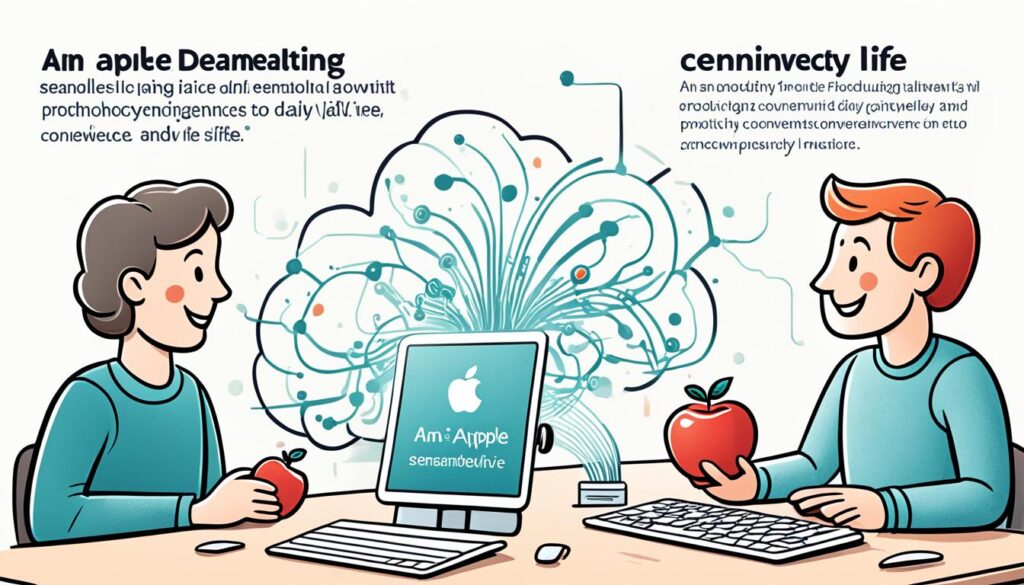Did you know about Apple’s OpenELM? It’s changing how the tech giant uses artificial intelligence. It focuses on keeping AI on the device itself, which keeps user data private.1 This awesome tech spans eight big language models. They range from having 270 million to 3 billion details in them. Running the models right on Apple devices makes things more private and efficient, boasting a 2.36% leap in accuracy over similar tech.1
What makes OpenELM stand out is its focus on being an on-device thing. This is different from other models like OpenAI’s which rely on cloud processing. Apple’s way means more privacy for users.12
By going open-source, Apple is inviting everyone to join in and improve OpenELM.1 People from everywhere can help make it better, pushing innovation in a way that’s open and honest. This helps everyone create AI in a responsible way.1
Soon, OpenELM will be a part of iOS 18. This means Apple devices will get quicker and smarter AI features. Users will enjoy smoother experiences and get more done.1
Apple’s OpenELM isn’t just about taking AI further. It shows Apple’s deep commitment to keeping our data safe and making devices work better. In putting AI power in our hands safely, Apple is changing how we’ll interact with tech in the future.1
Key Takeaways:
- Apple’s On-Device OpenELM initiative focuses on enhancing user privacy and efficiency by running language models directly on devices. With a suite of eight models ranging from 270 million to 3 billion parameters, OpenELM offers a 2.36% increase in accuracy over other models with similar configurations.1
- OpenELM contrasts with OpenAI’s cloud-based models, highlighting Apple’s commitment to on-device AI and user privacy.12
- OpenELM’s open-source nature promotes collaboration, transparency, and innovation in the AI community, democratizing access to cutting-edge technology.1
- The anticipated integration of OpenELM into iOS 18 suggests that Apple devices will deliver faster and more responsive AI-driven features.1
- Apple’s OpenELM sets new standards for on-device AI capabilities, prioritizing user privacy and device performance, and reshaping the future of AI-powered technology.1
Understanding OpenELM’s Approach to Language Models
OpenELM is unique because it uses a special tactic for arranging its parameters. This method greatly increases the model’s accuracy and performance1. OpenELM offers a big family of eight different language models. The models vary a lot, with parameters from 270 million up to 3 billion. This ensures they can meet a variety of needs3.
OpenELM stands out in creating efficient language models. It shows a 2.36% improvement in accuracy over other similar models1. This is thanks to its clever method of adjusting the model’s performance at every level. This leads to better output and predictive power.
Not just in accuracy, OpenELM models do well on a variety of tests. These include tasks like understanding prompts, handling tricky questions, and making sense of common knowledge3. This all proves how effective OpenELM’s method is.
When making language models, being efficient is very important. OpenELM keeps this in mind by finding a balance between how large a model is and how fast it works3. This balance makes the models practical, energy-efficient, and accessible while also aiming to cut costs, protect users, secure data, and support instant use.
A lot of focus is given to keeping user information safe with OpenELM. By working on the device itself, it avoids using the cloud1. This way, it keeps user data private and secure.
Layer-Wise Scaling Strategy
“OpenELM’s special way of managing its models maximizes their efficiency. It carefully chooses where to put parameters in each layer to optimize each level’s performance and accuracy.”3
The strength of OpenELM comes from its way of organizing model layers, thanks to Apple3. It changes layer sizes and abilities depending on their roles, leading to more efficient models. This strategy means OpenELM can perform well without needing too much computer power.
In the end, what makes OpenELM special is its approach to managing models. It carefully arranges parameters for the best performance and accuracy. With models ranging from 270 million to 3 billion parameters, it can meet a wide range of needs. OpenELM is all about creating efficient and powerful models for everyone worldwide.
OpenELM’s Commitment to Open Source Development
Apple has made OpenELM open source. This shows their dedication to working together, being open, and creating new things in the AI world. By sharing OpenELM, Apple welcomes people from everywhere to help make language models better.
The release of OpenELM on the Hugging Face Hub lets more researchers help out. This way of working together helps share knowledge. It also makes exploring new technology easier.
Being open about how OpenELM works is key. Apple shows everyone the training and data they use. This lets other researchers check their work and add to what Apple has done. This openness builds trust and makes sure new ideas are fair.
Apple’s OpenELM project is a big leap in AI tech we can use right on our devices. It’s all about working together, being clear, and coming up with new ideas openly.1
Apple’s open-source way lets everyone use top-notch language models like OpenELM. This makes it easy for smart minds everywhere to add to AI tech. Everyone benefits from the growth of AI.
Open source is great because it supports being open and working together. It lets researchers and developers share and learn from each other. This joint effort helps make amazing things possible with language models.
Enhancing User Privacy with On-Device Deployment
One cool thing about OpenELM is it works right on your device. This means it doesn’t need cloud servers, making your information safer.
With OpenELM, your data stays on your device, keeping it private and secure.4 This gives you more control over your information. It also lowers the chance of data leaks.
When OpenELM was added to iOS 18, it made privacy even better. Now, AI features work faster and smoother without sending your data away.4
Apple shows its dedication to keeping your data safe with OpenELM. All the AI stuff happens on your device. This not only makes things quicker but also keeps your data away from prying eyes.4
Thanks to OpenELM, there’s a new bar for making AI that respects your privacy. You can be sure that your personal details stay just that – personal.4
OpenELM vs. Other AI Initiatives
OpenELM and OpenAI both play a big role in AI, but they’re different. OpenAI uses big cloud-based models. OpenELM, on the other hand, works right on your device to keep your data safe5. This makes sure your info stays off the cloud and safe with you5. With OpenELM, Apple shows they really care about keeping our data private and secure5.
| OpenELM | OpenAI | |
|---|---|---|
| Privacy | Emphasizes on-device AI processing and keeps data localized5 | Relies on cloud-based models, potentially exposing user data to external servers |
| Performance | On-device processing ensures faster response times and improved efficiency65 | Scalability and processing capabilities depend on cloud infrastructure |
| Collaboration | Open source, enabling global collaboration and contribution from developers and researchers1 | Focused on proprietary development within the organization |
Comparing OpenELM to OpenAI, we see Apple’s strong focus on privacy and processing on our devices. OpenELM does away with cloud reliance, offering better privacy and efficient, fast AI right where we need it51
OpenELM and Publicly Available Data
Apple uses OpenELM to train models with data anyone can access. This focuses on privacy and trust. Using public data means OpenELM’s models are strong and fair.
“OpenELM’s training uses data everyone can see. This approach is clear and makes AI more ethical. It avoids bias and mistakes.”7
OpenELM uses lots of available data for better models. It uses big databases like The Pile and RedPajama. Together, they have 1.8 trillion bits of info.
Apple chooses to use public data to be open and work with researchers. This lets others check and add to OpenELM’s work.
“OpenELM picks datasets like The Pile and RedPajama for transparency. Apple wants to help and share with AI researchers.”7
Choosing public over private data stops bias in OpenELM models. It makes AI more fair and open.
Using public data lets anyone use and change OpenELM models. It helps researchers and developers tailor models to their needs.
OpenELM is serious about using public data for ethical AI. It builds trust and team spirit in the AI world.
“Using public data in OpenELM means everyone can check the models. This helps make AI better together.”7
OpenELM is leading in ethical AI by using public data. Its models are trusted and respected.
OpenELM and Ethical AI Training
OpenELM picks public data on purpose for ethical AI. This avoids private data problems, like bias and mistakes.
This matches the bigger goal of making AI responsible and fair. It focuses on being open, fair, and removing bias.
Using public data makes OpenELM models reliable and checkable by everyone. This is important for trust in AI.
Using public data lessens worry about hidden biases. It lets researchers check and improve OpenELM models more easily.
“OpenELM uses public data to make AI fairer. It invites experts to help enhance the models.”7
Also, using public data shows OpenELM’s honesty. It helps everyone understand the data shaping the models. This follows AI ethics.
By opening its data, OpenELM lets everyone tackle AI issues together. This creates stronger, more reliable AI systems.

Ethical Model Training with OpenELM
OpenELM trains with public data to be ethical in AI. This encourages sharing, reduces bias, and increases collaboration.
Using public data fits with OpenELM’s ethical stance. It broadens knowledge and helps researchers. This makes models more diverse and accurate.
By focusing on public data, OpenELM boosts sharing and collaboration in AI research. This improves model quality and trust.
“OpenELM’s public data use aims for responsible, open AI. It boosts sharing and joint improvement in AI research.”7
Comparison of OpenELM with Other Training Approaches
| OpenELM | OLMo | |
|---|---|---|
| Parameter Sizes | 270M, 450M, 1.1B, 3B5 | N/A |
| Performance | Slightly outperforms5 | N/A |
| Training Data Requirement | Half the training data5 | N/A |
Note: The performance and training data requirements are based on a comparison with OLMo.
OpenELM stands out by using public data, unlike OLMo. It offers models of various sizes. This showcases its efficiency.
OpenELM is a bit more accurate than OLMo, requiring less data. Its models aim for higher efficiency and lower resource use.
This focus on public data boosts OpenELM’s privacy, trust, and clarity in AI development.
“OpenELM, with its public data focus, leads over approaches like OLMo. It shows a commitment to getting better all the time.”5
OpenELM is pioneering in creating AI that values fairness and openness. It sets a high standard for AI systems.
The Cornet Toolkit for Model Training
Apple and OpenELM have teamed up to create Cornet. This toolkit changes how researchers train AI models. It’s great for various tasks like figuring out what’s in a picture to understanding scenes.
Cornet makes creating and tweaking AI models easy. Anyone can build models for their special projects with its simple tools. You can adjust the models to get them just right, adding cool features for better results.
What’s great about Cornet is how it works with OpenELM. This teamwork makes it easier for users to mix the best of both worlds. They get more out of their AI projects.
Together, Cornet and OpenELM let people dig deeper into AI. Making and improving AI models is faster and easier. This is thanks to Cornet’s easy-to-use setup and its connection to OpenELM.
Thanks to Cornet, the future of AI looks bright. People can try new ideas and make their AI even better. Cornet helps keep AI moving forward as it keeps changing.

| Feature | Description |
|---|---|
| Standard Model Creation | Create models with standard architectures for various tasks. |
| Custom Model Development | Design and develop novel models tailored to specific requirements. |
| Parameter Adjustment | Tailor the model’s parameters to optimize performance and accuracy. |
| Advanced Techniques | Incorporate advanced techniques and algorithms for enhanced model performance. |
| Integration with OpenELM | Seamless integration with the OpenELM framework for enhanced capabilities. |
“Cornet empowers researchers and engineers to unlock the true potential of deep neural network models. With its user-friendly interface and support for model customization, Cornet revolutionizes the training process and facilitates groundbreaking advancements in AI.”
– Reference:8,9
Apple’s Future with OpenELM
Rumors about iOS 18’s release are causing quite a buzz. It’s about the on-device AI and how OpenELM is a big part of it. Expectations are high for iOS 18 to bring better experiences and personalized features10.
Thanks to OpenELM, Apple plans to redefine smart technology10. We’re going to see smarter, quicker AI apps. They’ll offer solutions that are just right for you.
“Imagine AI models running on Apple’s chips, changing wearable tech. Think about AR glasses giving you info offline, thanks to AI.”10
With OpenELM in iOS 18, advanced AI on your device will be a game-changer10. This means smooth use without privacy worries or slow cloud services. Apple’s work with OpenELM could lead to exciting, personalized tech advances.

Key Advancements in OpenELM for iOS 18 Integration
| Advancements | Description |
|---|---|
| Advanced AI Functionalities | Through OpenELM, iOS 18 will get smarter features and capabilities for AI apps10. |
| On-Device Processing | OpenELM allows for quicker, in-device data handling, making AI features faster and more reliable1. |
| Efficient AI Models | With OpenELM’s innovations, AI works smoother, ensuring a great experience without slowing down10. |
| User Privacy | OpenELM keeps your data safe on your device, focusing on your privacy and security1. |
The Impact of OpenELM on Language Models
OpenELM stands out due to its focus on transparency, collaboration, and innovation. It champions trust and transparency by being open-source. This approach promotes accountability and careful review within the AI sphere9.
Apple also prioritizes user security and privacy. Their commitment matches OpenELM’s aim for responsible AI development.
Conclusion
Apple’s new On-Device OpenELM brings endless possibilities for AI on our devices. It not only keeps our data safe but also makes devices run better. OpenELM is 2.36% more accurate than older tech like OLMo, showing big leaps in machine learning.11Apple’s MLX lets developers use machine learning while keeping our info private.11.
OpenELM shares training tools and data which helps developers work together.11This move makes AI development more open and secure than ever.11OpenELM’s models work for many needs, from small to huge tasks. Its unique design and framework set it apart, attracting developers and researchers.12.
Apple spends about $1 billion yearly on AI. The diverse data sets for OpenELM lay a strong groundwork for understanding and creating languages.13This data helps OpenELM learn better and be more precise. OpenELM’s structure has cool features that make it work better and faster.13.
As OpenELM grows, we’re heading into a future where top AI tech is user-friendly and safe. By sharing OpenELM, Apple pushes for open research and clear AI work.13OpenELM is changing the game for language models, helping everyone and the AI field. It’s all about innovation, giving power to creators while protecting our privacy.
In sum, Apple’s OpenELM technology is making a future with AI that is more seamless, open, and safe for us all.
FAQ
What is Apple On-Device OpenELM?
What is the benefit of OpenELM’s layer-wise scaling strategy?
How does OpenELM prioritize user privacy?
What differentiates OpenELM from other AI initiatives like OpenAI?
How does OpenELM utilize publicly available data?
What is the Cornet toolkit?
Will OpenELM be integrated into Apple’s product ecosystem?
How does OpenELM impact the field of language models?
What can we expect in the future with OpenELM?
Source Links
- https://medium.com/@learngrowthrive.fast/apple-openelm-on-device-ai-88ce8d8acd80
- https://venturebeat.com/ai/what-we-know-about-apples-on-device-ai/
- https://kili-technology.com/large-language-models-llms/openelm-how-it-s-trained-and-how-to-leverage-apple-s-open-source-model
- https://www.linkedin.com/pulse/revolutionizing-ai-apples-openelm-models-bring-privacy-gonzales-2fhfe
- https://www.justthink.ai/blog/apples-openelm-brings-ai-on-device
- https://www.nomtek.com/blog/on-device-ai-apple
- https://www.infoq.com/news/2024/05/apple-llm-openelm/
- https://suleman-hasib.medium.com/exploring-apples-openelm-a-game-changer-in-open-source-language-models-4df91d7b31d2
- https://bdtechtalks.com/2024/04/29/apple-openelm/
- https://www.yahoo.com/tech/apples-openelm-teases-future-ai-103247507.html
- https://medium.com/@zamalbabar/apple-unveils-openelm-the-next-leap-in-on-device-ai-3a1fbdb745ac
- https://ai.plainenglish.io/openelm-apples-leap-towards-open-source-language-models-e84597e027d2
- https://ajithp.com/2024/05/04/openelm-apples-groundbreaking-open-language-model/










